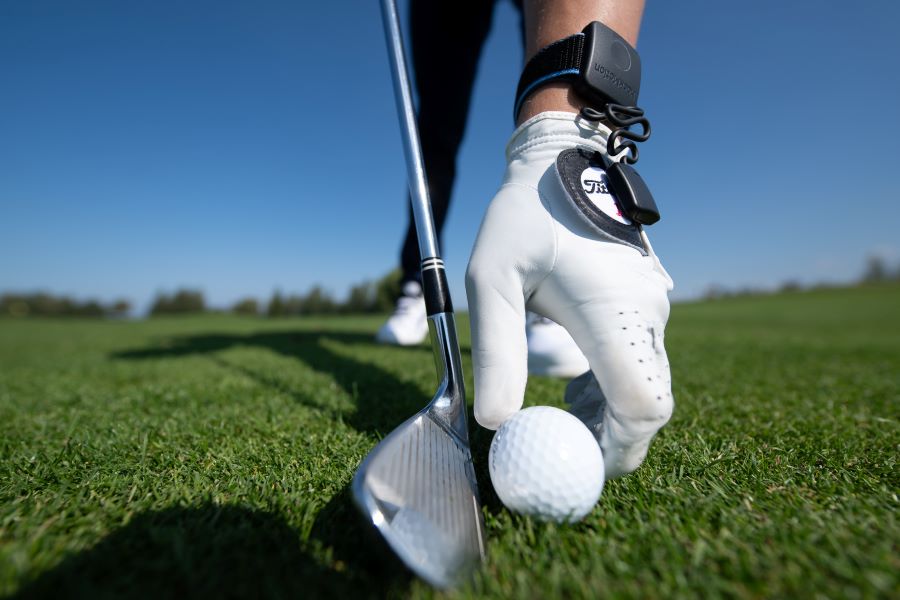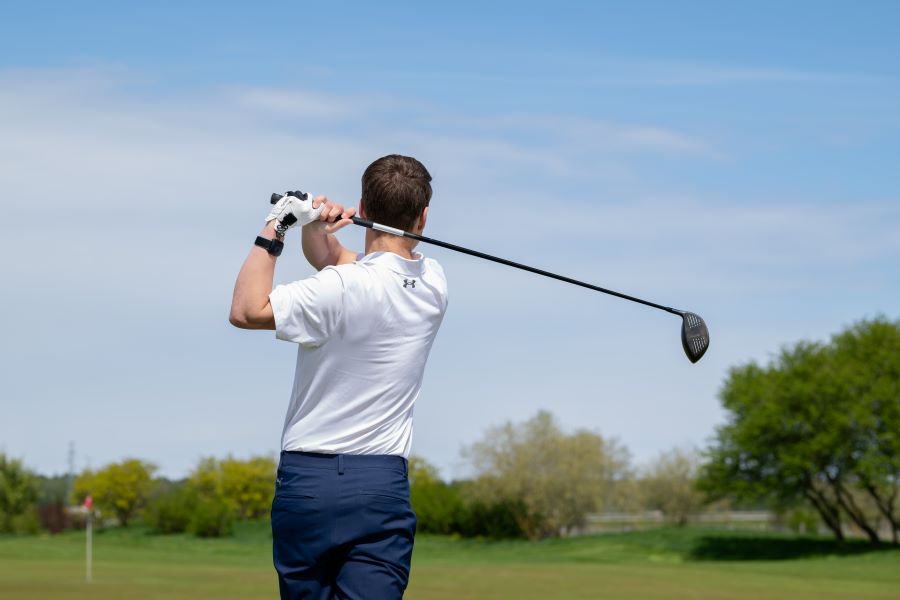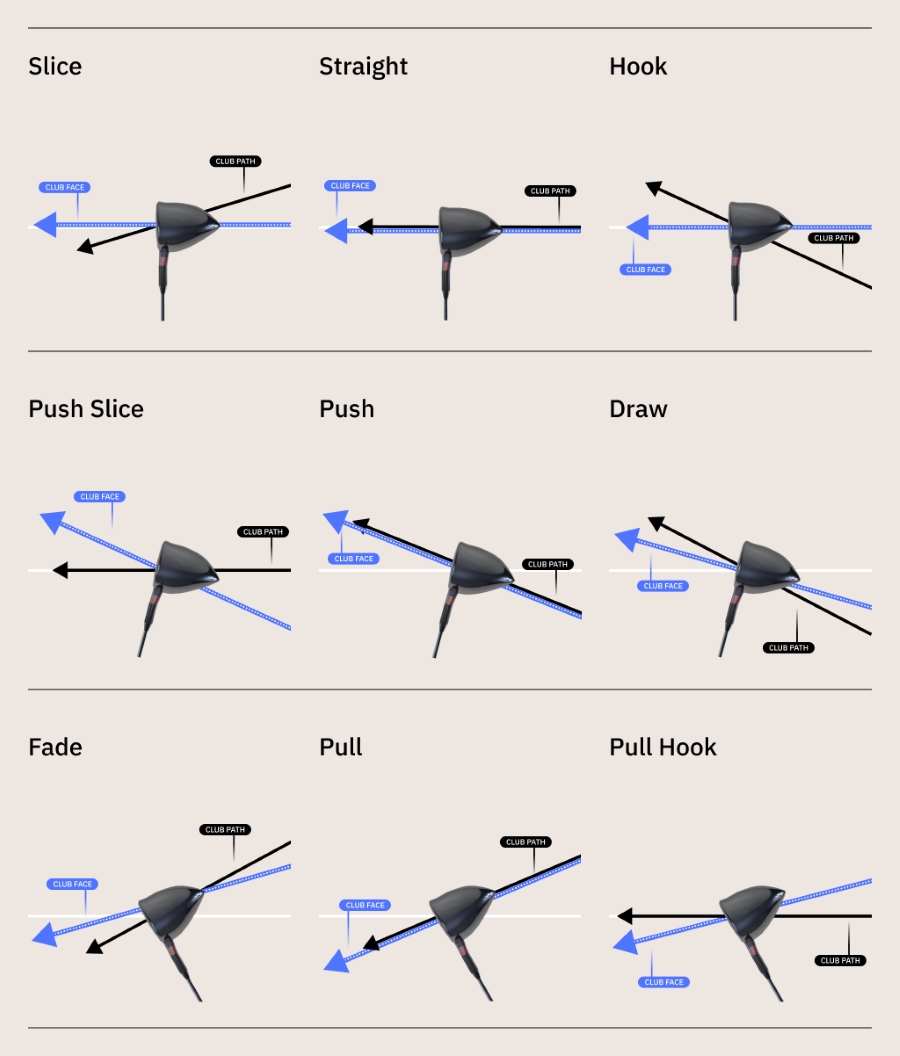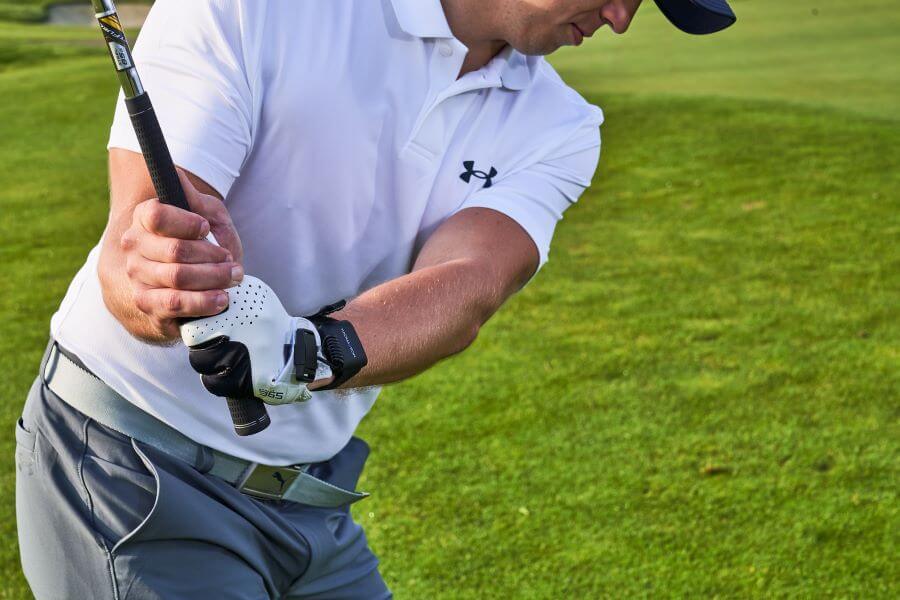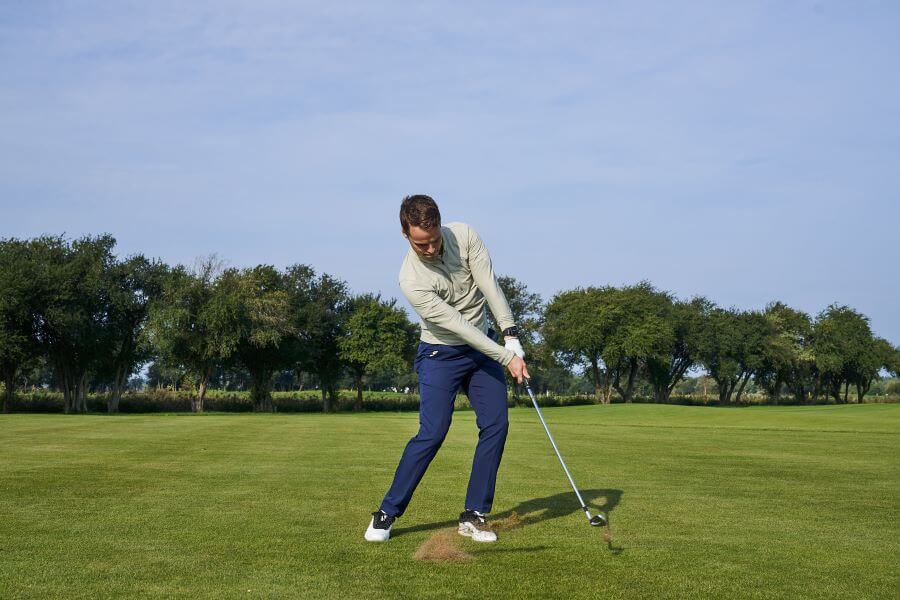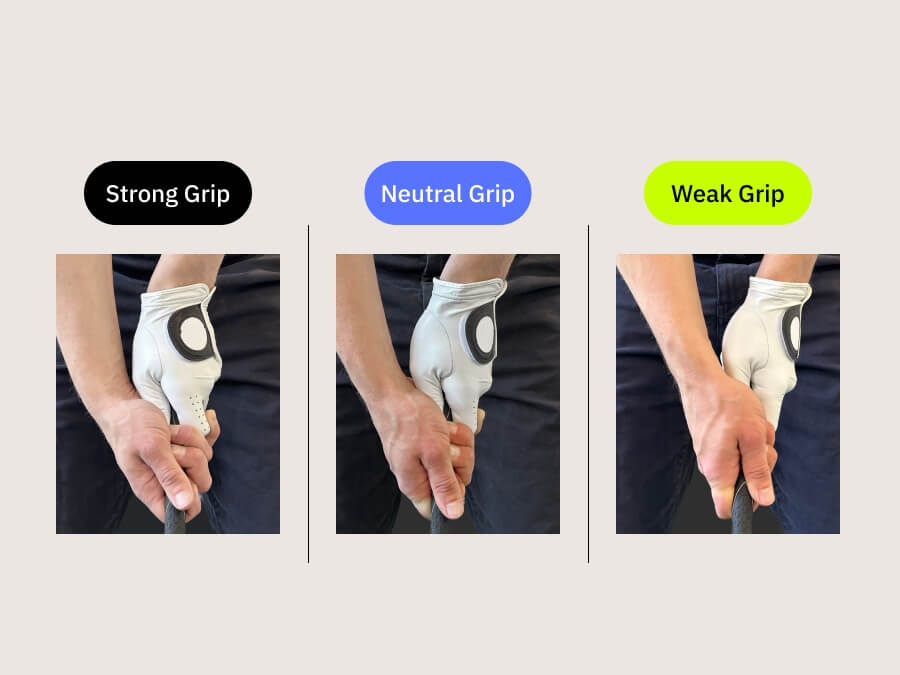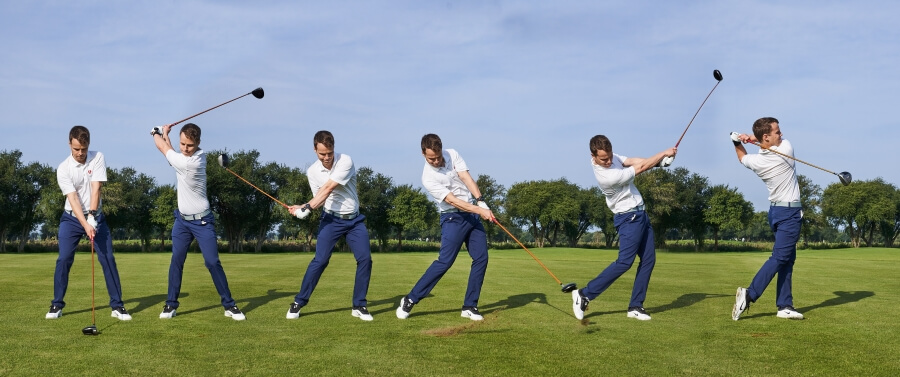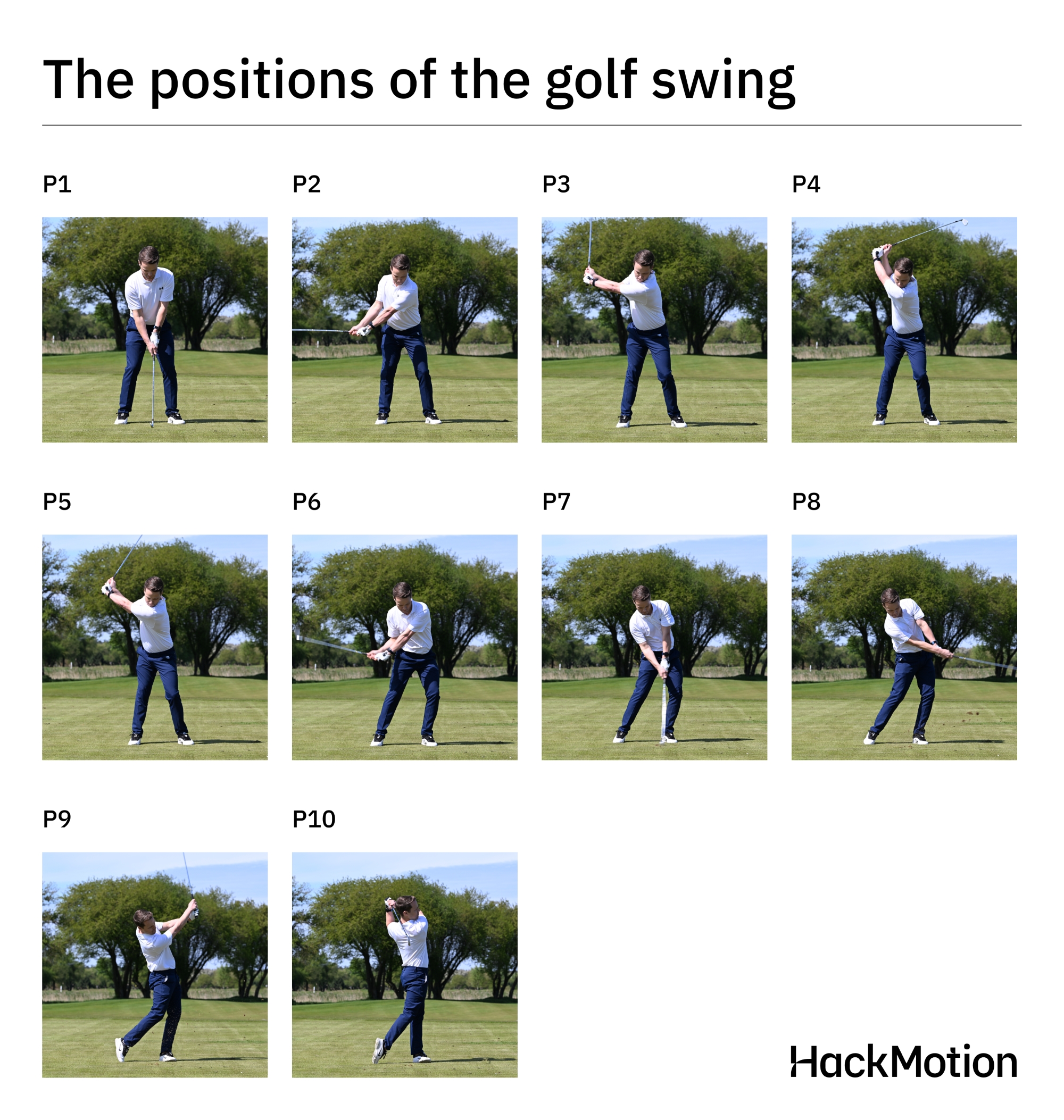Strong Grip vs Weak Grip in Golf (What are They & Which is Better?)
In golf, the positioning of the hands is known as a strong grip, a weak grip, or a neutral grip.
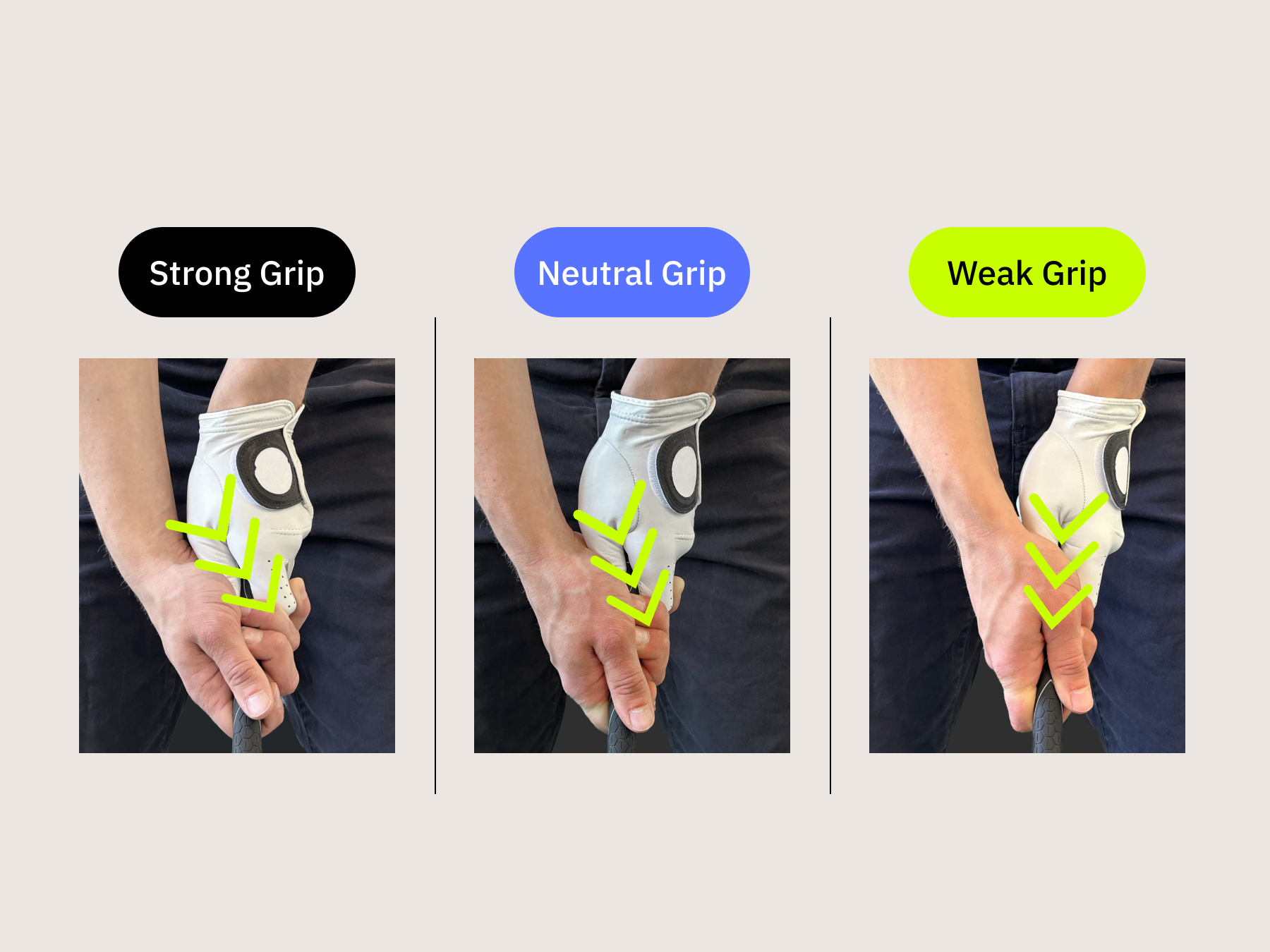
Understanding how the strong and weak grips impact your ability to square the clubface is crucial. We will examine whether you should use a strong, weak, or neutral grip and how it will impact your game.
Contents
Strong Grip vs Weak Grip (What’s The Difference)
Strong Grip = More Closed Clubface: A strong grip typically encourages a closed clubface at impact due to the lead hand pronating (rotating inward), which can promote a draw or hook.
Weak Grip = More Opened Clubface: A weak grip encourages an open clubface at impact due to the lead hand supinating (rotating outward), which promotes a fade or slice tendency.
What is a Strong Grip?
- The “V” shapes formed by the thumbs and index fingers point more toward the trailing shoulder (right shoulder for a right-handed golfer).
- More knuckles (usually three or more) on the lead hand are visible from the golfer’s perspective.
- Closed Clubface: A strong grip typically encourages a closed clubface at impact due to the lead hand pronating (rotating inward), which can promote a draw or hook.
- Ball Flight: Tends to create a lower ball flight due to the de-lofting effect of the closed face.
- Swing Requirements: Requires effective body rotation through impact to prevent excessive closing of the face and minimize the risk of hooking.
- Common Downside: Increased chance of over-drawing or hooking the ball, especially if body rotation is insufficient.
What is a Weak Grip?
- The “V” shapes point more toward the golfer’s nose or chin.
- Fewer knuckles (usually one or two) on the lead hand are visible.
- Opened clubface A weak grip encourages an open clubface at impact due to the lead hand supinating (rotating outward), which promotes a fade or slice tendency.
- Ball Flight: Often results in a higher ball flight because of the added loft from the open clubface.
- Swing Requirements: May require compensations, like added wrist rotation or “motorcycle move,” to square the face at impact and prevent slicing.
- Common Downside: Difficulty in closing the clubface, potentially leading to a fade or slice, especially if body rotation or wrist action is insufficient.
If you prefer watching video to reading, check out the video below by coach Rob Cheney.
Benefits of a Strong Golf Grip
The strong golf grip has some benefits, making it the most popular choice among amateur players:
- Promotes a Draw or Reduce a Slice: The closed clubface at impact helps promote a draw, making it a good choice for players who struggle with slicing. Most golfers slice because the clubface is left open at impact, but the strong grip makes it difficult to leave the clubface open.
- Lower Ball Flight: The strong grip de-lofts the club slightly, creating a more penetrating, lower ball flight. This is beneficial in windy conditions or on firmer courses where a lower trajectory gives more control and roll.
- Enhances Power: with the strong grip activating the hands and arms just a bit more, many players feel as though they can go after the ball with full power and a little extra speed.
- Limit Clubface Rotation Needs: For players who prefer a more passive release, a strong grip can allow them to rely on body rotation to control the clubface without a lot of wrist manipulation.
- Extra stability: stronger grips may make you feel as though you have more control over the club head. Don’t confuse a strong grip with a tight grip; strong refers to position, and tight refers to pressure.
Negatives of a Strong Grip
If the strong grip was perfect, everyone would have it.
Here are a few negatives to look out for:
- Too much draw: sick of hitting a draw on every golf swing; check to make sure it’s not the grip. Players with a strong grip may face challenges with over-hooking or struggles on shots requiring added loft, like delicate pitch shots.
- Too much right hand: at some point, your right hand can get too active in the swing; I would watch out for this, especially in the short game
- Increased tension: the way the strong grip wraps that right hand around the club can promote increased tension for some players.
When to Use the Strong Grip
The strong grip is the ultimate slice fixer, but there are other times you can benefit from using the stronger grip; they include:
- Players who naturally rotate well through impact.
- Those who play in windy conditions or desire a lower trajectory.
What is a Weak Grip?
A weak grip for a right-handed player means the left hand is rotated outward so that fewer knuckles are visible when looking down. The right hand is positioned more on top of the club, giving it a less active role in the golf swing.
This grip positioning makes it easier to keep the clubface open through impact, promoting a fade or reducing a hook.
By having the lead hand in a supinated position, the likelihood of the clubface closing during the swing is minimized, allowing for higher, more controlled ball flights. For golfers who hook the ball, this is a much better position to be in.
Benefits of a Weak Golf Grip
The main benefit of a weak grip is the ability to hit a fade; when approaching a green with the pin on the right side, weaken the grip and hit it toward the middle.
- Higher, softer fades: the high and soft fade is such a helpful shot; the ball lands on the green and stays where you need it. The weak grip often helps golfers have a slightly more open face at impact, creating these softer fade-type shots.
- Great feel around the greens: for a variety of short game shots, you want to improve overall feel; the weaker grip allows for a better feel for a variety of reasons; if you often skull shots or have too much strength in the grip, weakening it could help.
- Less grip pressure: the tendency to grip the club to death is greatly reduced with a weaker golf grip.
- Better timing and tempo: although the weak grip can feel a little less powerful at times, it can help you feel a smoother transition from backswing to downswing and improve the overall tempo of the swing.
Negatives of a Weak Grip
The weak grip can put you at a disadvantage if you need help with power in your golf swing.
- Could make a slice worse: If you weaken the grip too much, it could result in a slice; as I’ve mentioned, make sure the changes to your grip are subtle.
- Lower clubhead speed: a golfer with a weaker grip will sometimes have a slower swing speed than those with a higher swing speed since they try to give themselves time to close the club face.
When to Use a Weak Grip
You don’t have to keep the weak grip in play all the time; many golfers will use the weak grip when playing short game shots to help with a softer landing and better control.
- Players who prefer a fade shot or are prone to hooking.
- Anytime a higher and softer shot is needed.
- Around the greens for better feel and control.
- Players who like to work the ball prefer a weaker grip.
What is a Neutral Grip?
The neutral grip is your home base.
With the neutral grip, the left hand is positioned more in the center with no turning towards the left or the right. The right hand can then fit on the club in a more neutral position.
A neutral grip has the perfect balance of all the positives of the weak vs strong grip. For instance, you will still feel the ability to square up the clubface, but your grip pressure may be a little lighter.
Benefits of a Neutral Grip
- Improved shot-making capabilities: The strong grip increases the chance of a hook, and the weak grip increases the chance of a slice. With the neutral grip, you can take your swing and trust a square clubface.
- Improved Loft and Launch Control: A neutral grip maintains the club’s designed loft at impact, which is useful for players looking to achieve a predictable ball trajectory and ideal launch conditions for each club.
- Flat wrist at the top: golfers with a neutral grip tend to have a flat wrist at the top of their backswing, making it easier to square a clubface early (something the professionals are very good at).
Negatives of a Neutral Grip
With the neutral grip, you won’t find too many negatives. Most golfers who can obtain a neutral grip eventually learn that it’s a consistent and solid option that results in a straight shot.
- Limited Shot Bias: While a neutral grip allows for shot flexibility, it doesn’t favor a natural draw or fade bias. This means players might find it harder to develop a consistent shot shape compared to a strong or weak grip, which naturally promotes a draw or fade respectively.
- Less Power Generation: While a neutral grip allows for stable control, it may not maximize power for players who depend on a specific shot shape to generate speed. Strong grips often naturally close the face for added power, while weak grips encourage a fade. The neutral grip, being between these two, may feel less powerful without specific adjustments in the swing mechanics
Strong or Weak Golf Grip – Who Wins?
In the end, you have to find a grip that allows you to consistently return the clubface to square. Both grips can be highly effective, but the “winner” depends on the individual’s swing type, shot preferences, and goals.
A lot of golfers struggle with slicing due to an open clubface because of their weak grips (often palmy as well). A weaker grip requires more active hand release, which most amateur players can not execute consistently well.
That is why at HackMotion we recommend testing if a stronger grip might not improve a player’s shot shape and consistency. By wearing the HackMotion sensor, you can also measure the position of your wrists at set up and throughout the swing and see how the wrists change from one swing to the next.

How to Know if Strong Grip is Better for My Swing?
One of the best ways to work on the grip is to use a swing analysis tool like HackMotion.
HackMotion lets you analyze your wrist position and provides drills and feedback on whether it is optimal for you.
Knowing if your grip is optimal without the help of a golf coach can be difficult, but HackMotion can take the place of a coach and do the analysis.
If you have a palmy or too weak grip, HackMotion will be able to detect it in your address position and provide guidance on how to fix it.
If you are struggling with a slice it might be due to a weak grip and an open clubface, with HackMotion you will be able to identify the fault and fix it.
FAQs
Do most pros have a strong or weak grip?
Tour pros utilize a wide range of grip strengths, with most using a grip that is slightly on the strong side of neutral. This configuration helps them manage clubface control and impact conditions to optimize ball flight, particularly on longer shots where stability and power are priorities. Pros with slightly stronger grips typically experience a more closed clubface at impact, promoting lower ball flight and more draw bias.
What happens if your golf grip is too strong?
If your golf grip is too strong, you will start to hook your golf shots.
How do I know if my golf grip is too weak?
If your golf grip is too weak, you may feel a lack of power or notice that the clubface is too far open at impact. If you suddenly start hitting a fade or a slice, your weak grip could be the culprit.
Final Thoughts
At this point, you should have a strong understanding of the difference between a strong grip and a weak grip.
If you have been fighting a slice for years try using HackMotion and analyse your swing, it might be your weak grip that is causing the issue.





